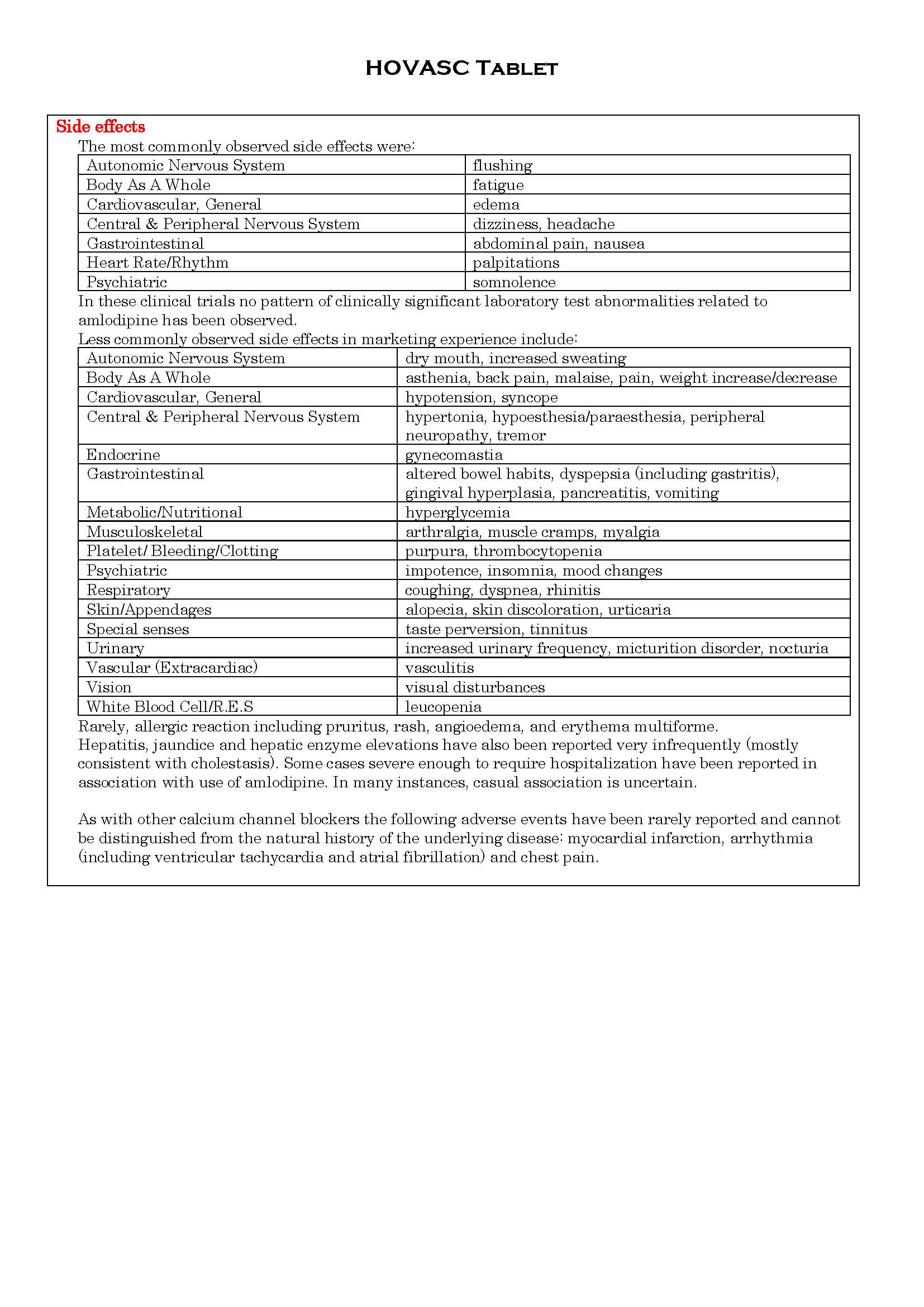HOVASC Tablet
ក្រុមហ៊ុនផលិតឱសថ:
HOVID Bhd., Malaysia
- សារធាតុសកម្ម
- ប្រសិទ្ធិភាពព្យាបាល និង កម្រិតប្រើប្រាស់
- ហាមប្រើ
- ផលរំខាន
- អន្តរប្រតិកម្ម
- ស្ត្រីមានផ្ទៃពោះ និង ស្ត្រីបំបៅដោះកូន
- ការប្រុងប្រយ័ត្នជាពិសេស
- សកម្មភាពឱសថ បរិយាយប័ណ្ណឱសថ
-
សារធាតុសកម្ម
-
ប្រសិទ្ធិភាពព្យាបាល និង កម្រិតប្រើប្រាស់
For the first line treatment of hypertension and can be used as the sole agent to control blood pressure in the majority of patients. Patients not adequately controlled on a single antihypertensive agent may benefit from the addition of amlodipine, which has been used in combination with a thiazide diuretic, alpha blockers, beta adrenoceptor blocking agent, or an angiotensin-converting enzyme inhibitor. Amlodipine is indicated for the first line treatment of myocardial ischemia, whether due to fixed obstruction (stable angina) and/or vasospasm/vasoconstriction (Prinzmetal’s or variant angina) of coronary vasculature.
Amlodipine may be used where the clinical presentation suggests a possible vasospastic/vasoconstrictive component but where vasospasm/vasoconstriction has not been confirmed. Amlodipine may be used alone, as monotherapy, or in combination with other antianginal drugs in patients with angina that is refractory to nitrates and/or adequate doses of beta blockers.
Dosage and administration
For moth hypertension and angina the usual initial dose is 5mg amlodipine once daily which may be increased to a maximum dose of 10mg depending on the individual patient’s response.
No dose adjustment of amlodipine is required upon concomitant administration of thiazide diuretics, beta-blockers, and angiotensin-converting enzyme inhibitors.
See the package insert about the details below:
Use in the Elderly/children/Patients with impaired hepatic function/ Renal failure.
-
ហាមប្រើ
In patients with known hypersensitivity to dihydropyridine derivatives.
-
ផលរំខាន

-
អន្តរប្រតិកម្ម
In vitro data in human plasma indicate that amlodipine has not effect on the protein binding of drugs tested (digoxin, phenytoin, warfarin, and indomethacin).
See the package insert about the details below:
Cimetidine
Sildenafil
Atorvastatin
Digoxin
Ethanol (alcohol)
Warfarin
In clinical trials, amlodipine has been safely administered with thiazide diuretics, beta-blockers, angiotensin-converting enzyme inhibitors, long-acting nitrates, sublingual nitroglycerin, digoxin, warfarin, NSAIDs, antibiotics, and oral hypoglycemic drugs.
-
ស្ត្រីមានផ្ទៃពោះ និង ស្ត្រីបំបៅដោះកូន
Pregnancy
Studies have not been done in humans. No evidence teratogenicity or other embryo/fetal toxicity was found in animal studies. Nevertheless, amlodipine should be used during pregnancy only if the potential benefit justifies the potential risk to the fetus.
Nursing Mothers:
It is not known whether amlodipine is excreted in human milk. In the absence of this information, it is recommended that nursing be discontinued while amlodipine is administered.
-
ការប្រុងប្រយ័ត្នជាពិសេស
General:
Vasodilation induced by amlodipine is gradual in onset. Even though, acute hypotension has rarely been reported after oral administration of amlodipine, caution should be exercised when administering amlodipine particularly in patients with severe aortic stenosis. In general, calcium channel blockers should be used with caution in patients with heart failure.
See the package insert about the details below:
- Beta-Blocker Withdrawal
- Patients with Hepatic failure
- Increased Angina and/or Myocardial Infarction
-
សកម្មភាពឱសថ
Amlodipine is a dihydropyridine calcium antagonist. It acts by selective inhibition of transmembrane influx of calcium ions into the cardiac muscle and vascular smooth muscle through specific ion channels; thus modulating the contractile process of these cells.
Amlodipine has a greater effect on vascular smooth muscle cells than on cardiac muscle cells.
Amlodipine is a peripheral arterial vasodilator that acts directly on vascular smooth muscle to cause a reduction in peripheral vascular resistance and reduction in blood pressure.
Amlodipine exhibits negative inotropic effects in vivo, but appears to have no significant effect on the sinoatrial or atrioventricular node in humans.
Although not fully defined, the mechanism of action of amlodipine is relieving angina is thought to be as follows:
Exertional Angina: Amlodipine reduces the total peripheral resistance (afterload) against which the heart works and reduces the rate pressure product. Therefore, in patients with exertional angina, myocardial oxygen demand is reduced, at any given level of exercise.
Vasospastic Angina: Amlodipine has been demonstrated to block constriction and restore blood flow in coronary arteries and arterioles in response to calcium, potassium epinephrine, serotonin, and thromboxane A2 analog in experimental models and in human coronary vessels in vitro. This inhibition of coronary spasm is responsible for the effectiveness of amlodipine in vasospastic (Prinzmetal’s variant) angina.
*ព័ត៌មានឱសថត្រូវបានរៀបរៀងដោយ អ៊ីម៉ាតុគឹ មេឌីក (ខេមបូឌា) ដោយផ្អែកលើប្រភពព័ត៌មានខាងក្រោម។ សម្រាប់ព័ត៌មានលម្អិត សូមស្វែងរកនៅក្នុងក្រដាសព័ត៌មាននៃឱសថនីមួយៗ ឬ សាកសួរទៅកាន់ក្រុមហ៊ុនឱសថឬតំណាងចែកចាយនៃឱសថនីមួយៗ។
ប្រភពព័ត៌មាន៖
- ក្រដាសព័ត៌មាននៃឱសថសម្រាប់អ្នកជំនាញវេជ្ជសាស្ត្រដែលប្រើប្រាស់នៅប្រទេសជប៉ុន (Pharmaceutical and Medical Devices Agency, Pmda): https://www.pmda.go.jp
- ព័ត៌មានសង្ខេបនៃឱសថសម្រាប់អ្នកជំងឺដែលប្រើប្រាស់នៅប្រទេសជប៉ុន: http://www.rad-ar.or.jp
